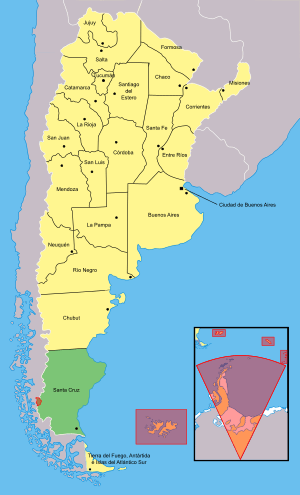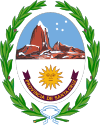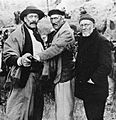Santa Cruz Province, Argentina facts for kids
Quick facts for kids
Santa Cruz
|
|||
|---|---|---|---|

Clockwise from top: Cueva de las Manos, Harbour of Río Gallegos, Perito Moreno Glacier (Los Glaciares National Park), Río Pinturas.
|
|||
|
|||

Location of Santa Cruz within Argentina
|
|||
| Country | Argentina | ||
| Capital | Río Gallegos | ||
| Departments | 7 | ||
| Municipalities | 27 | ||
| Area | |||
| • Total | 243,943 km2 (94,187 sq mi) | ||
| Population
(2010)
|
|||
| • Total | 272,524 (Ranked 23rd) | ||
| • Density | 1.1/km2 (3/sq mi) | ||
| Demonym(s) | santacruceño | ||
| Time zone | UTC−3 (ART) | ||
| ISO 3166 code | AR-Z | ||
Santa Cruz is a large province in the southern part of Argentina. It is located in a region called Patagonia. To its west and south, Santa Cruz shares a border with Chile. The Atlantic Ocean is to its east.
Santa Cruz is the second largest province in Argentina. However, it has the fewest people living in mainland Argentina. This means there's lots of open space! Two famous places here are Perito Moreno National Park and Los Glaciares National Park.
Contents
Exploring Santa Cruz Province
Santa Cruz is known for its amazing natural beauty. It has huge glaciers, vast plains, and a long coastline.
Where is Santa Cruz Located?
Santa Cruz is in the very south of Argentina. It's part of the wild and windy Patagonia region. The capital city is Río Gallegos. This city is an important port on the Atlantic coast.
What is Santa Cruz Like?
Santa Cruz has a cool, dry climate. Strong winds are common, especially in the open plains. The landscape changes from icy glaciers in the west to dry grasslands in the center. Along the coast, you'll find cliffs and beaches.
Natural Wonders
- Glaciers: The most famous is the Perito Moreno Glacier in Los Glaciares National Park. It's one of the few glaciers in the world that is still growing! You can watch huge chunks of ice break off and fall into the lake.
- Ancient Art: Cueva de las Manos (Cave of the Hands) is a UNESCO World Heritage site. It has ancient cave paintings of hands made by people thousands of years ago.
- Wildlife: The province is home to many animals. You can see guanacos (like small llamas), rheas (large birds), and pumas. Along the coast, there are penguins, sea lions, and many types of seabirds.
Economy and Resources
The economy of Santa Cruz mainly relies on a few key activities.
Mining
Santa Cruz is rich in natural resources.
- Coal: Río Turbio is Argentina's only active coal mine.
- Other Minerals: There is also mining for gold, clay, gypsum, and salt. These minerals are important for different industries.
Sheep Farming
Sheep farming is a very important part of the economy. Sheep are raised for both their wool and their meat. This industry has been a big part of Santa Cruz's history for a long time.
Government of Santa Cruz
Like other provinces in Argentina, Santa Cruz has its own government.
Who Leads Santa Cruz?
The main leader of the province is the Governor. The current Governor is Daniel Peralta. He belongs to a political group called the FPV. The Governor works to make decisions for the province and its people.
Santa Cruz also sends representatives to the national government in Argentina.
These representatives help make laws for the whole country.
| Provinces of Argentina | |
|---|---|
| Buenos Aires | Buenos Aires Province | Catamarca | Chaco | Chubut | Córdoba | Corrientes | Entre Ríos | Formosa | Jujuy | La Pampa | La Rioja | Mendoza | Misiones | Neuquen | Río Negro | Salta | San Juan | San Luis | Santa Cruz | Santa Fe | Santiago del Estero | Tierra del Fuego, Antarctica, and South Atlantic Islands | Tucumán | |
Images for kids
-
Ochre-ink art in Cueva de las Manos, Santa Cruz. Made by the long-vanished Toldense people, they are 13,000–9,000 years old.
-
Néstor and Cristina Kirchner (center) in conference with fellow Patagonia-area lawmakers.
-
The windswept Patagonian landscape of Santa Cruz.
-
Argentine Lake, near El Calafate.
-
Perito Moreno Glacier, near El Calafate. Until recently, the only glacier of its type in the world that was still expanding.
See also
 In Spanish: Provincia de Santa Cruz para niños
In Spanish: Provincia de Santa Cruz para niños










